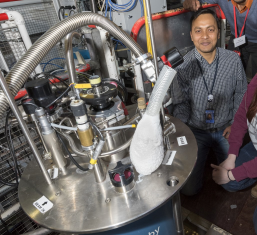Conveners
Early Career Presentations
- Mark Telling (STFC)
Molecular magnets consisting of metal ions surrounded by organic ligands offer a playground for investigating and manipulating the strength and nature of magnetic interactions present in a material. One possibility is to adjust the value of the magnetic spin centres in the molecular magnet, which means the crossover between quantum and classical regimes can be examined. This is realised by...
The pentanary oxides PbM2Ni6Te3O18, where M = Mn, Fe, Co, Zn, allow magnetic frustration to be tuned by changing the transition metal ion M. These compounds contain Ni2+ zigzag chains along the c- axis which order antiferromagnetically below TN, in addition to a kagome-like interchain structure in the a-b plane which becomes magnetically frustrated when coupled ferromagnetically. The...
We present simulations of the effect of quantum tunnelling between muonium sites in benzene crystals that contain methyl groups. These are added to different carbon atoms, such that they alter the available transition pathways for tunnelling between candidate muon sites. The calculations are based on density functional theory, combining phonon computations (of the zero point energy of the...
"Muon spin spectroscopy and in particular the avoid level crossing (ALC) technique is a sensitive probe of electron spin relaxation (eSR) in organic semiconductors. In complex ALC spectra, eSR can be challenging to extract, as it requires the modelling of overlapping ALCs, where covariance between parameters can result in significant uncertainties. Here we demonstrate a general method
to...
We apply quantum beam of muon to understand life phenomena like electron transfer in protein/DNA, detection of O2 in tissues, etc. Using muon, we propose a new noninvasive muon method to detect hypoxia in tumor/cancer tissue which will help to manage the treatment and early-stage diagnosis of cancer. We have tested the sensitivity of muon method for hypoxia detection and successfully detected...
Optimising the sample mounting to stop the muon beam is helpful when planning experiments with limited sample quantity. Using the instrument range curve is a good start in simple cases but computational tools can be used to help for more complex cases. We have established a design, search, and optimisation (DSO) process using musrSim and SRIM software tools to help in planning complex...

